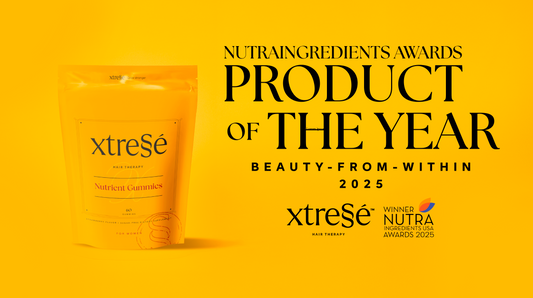Hair loss is a deeply personal issue that affects millions of women, often beginning in the reproductive years and increasing with age. To provide clarity on this common challenge, Xtressé co-founder, Dr. Matt Leavitt has co-authored an in-depth article addressing the causes, impacts, and treatments for female hair loss in a recent issue of Dermatology Times. This article explores the root causes of hair loss and highlights practical solutions and the latest advancements in care.
The most common type of female hair loss is androgenetic alopecia (AGA), also known as female pattern hair loss (FPHL). Other types include alopecia areata (AA), telogen effluvium (TE), and conditions like lichen planopilaris and traction alopecia. Hair loss can have a profound emotional toll, contributing to lower self-esteem, anxiety, and depression.
Causes of Hair Loss
Hair loss in women arises from various factors:
-
Hormonal Imbalances
Dihydrotestosterone (DHT) plays a key role in FPHL, particularly in those genetically predisposed. Conditions like PCOS, thyroid disorders, menopause, and postpartum hormonal changes also disrupt hair growth, leading to thinning or shedding. -
Nutrient Deficiencies
Nutrients like iron, vitamins (A, D, E, and B-complex), zinc, and selenium are vital for hair health. Deficiencies can cause brittle hair and shedding, but excessive supplementation may lead to toxicity. -
Inflammation and Oxidative Stress
Systemic and localized inflammation, along with oxidative stress, contribute to conditions like alopecia (AGA) and alopecia areata (AA), disrupting normal hair follicle function. -
Aging and Cellular Changes
Aging leads to thinner, drier, and more brittle hair due to genetic, environmental, and cellular factors.
Treatments and Innovations
FDA-approved options are limited, but alternative therapies are gaining traction:
-
Natural Supplements
- Saw Palmetto: Inhibits DHT, improving hair density in FPHL and TE.
- Horsetail Extract: Reduces DHT activity, promoting regrowth.
- Pumpkin Seed Oil: Enhances hair growth in AGA.
-
Anti-Inflammatory Agents
- Curcumin (Turmeric): Combats inflammation and oxidative stress.
- Pea Sprout Extract: Reduces shedding and boosts density.
-
Vitamins and Antioxidants
- Vitamins E and C, fish oil, and black currant seed oil improve hair thickness and reduce shedding.
-
Emerging Innovations
- Nicotinamide Mononucleotide (NMN): Supports cell health, reduces inflammation, and strengthens follicles.
- Taurine: Protects against follicle damage with antioxidant and anti-inflammatory properties.
Nutritional Considerations
Balanced nutrient intake is crucial for hair health. While deficiencies can worsen hair loss, excessive supplementation, especially biotin, can lead to toxicity or interfere with diagnostic tests. Biotin-free supplements are a safer alternative.
Conclusion
With limited FDA-approved treatments, addressing the root causes of hair loss through hormonal balance, nutrient optimization, and inflammation control offers effective solutions. Emerging natural therapies and innovations provide hope for improving hair health and overall well-being.
To help combat these root causes of hair loss and create healthy hair regeneration, Xtressé has created the first-of-its-kind hair growth gummy. These delicious gummies are powered by a modern, proprietary X3-Bioactive Blend™ born from regenerative medicine. They present a science-backed alternative to ineffective and invasive pills and topical treatments.
Explore the full article to uncover actionable advice and expert recommendations. Together, we can help you take the first step toward healthier, more confident hair care.
*The product and statements herein have not been evaluated by the Food and Drug Administration (FDA). Xtressé™ Hair Growth Gummies are not intended to diagnose, treat, cure, or prevent any disease or condition.




